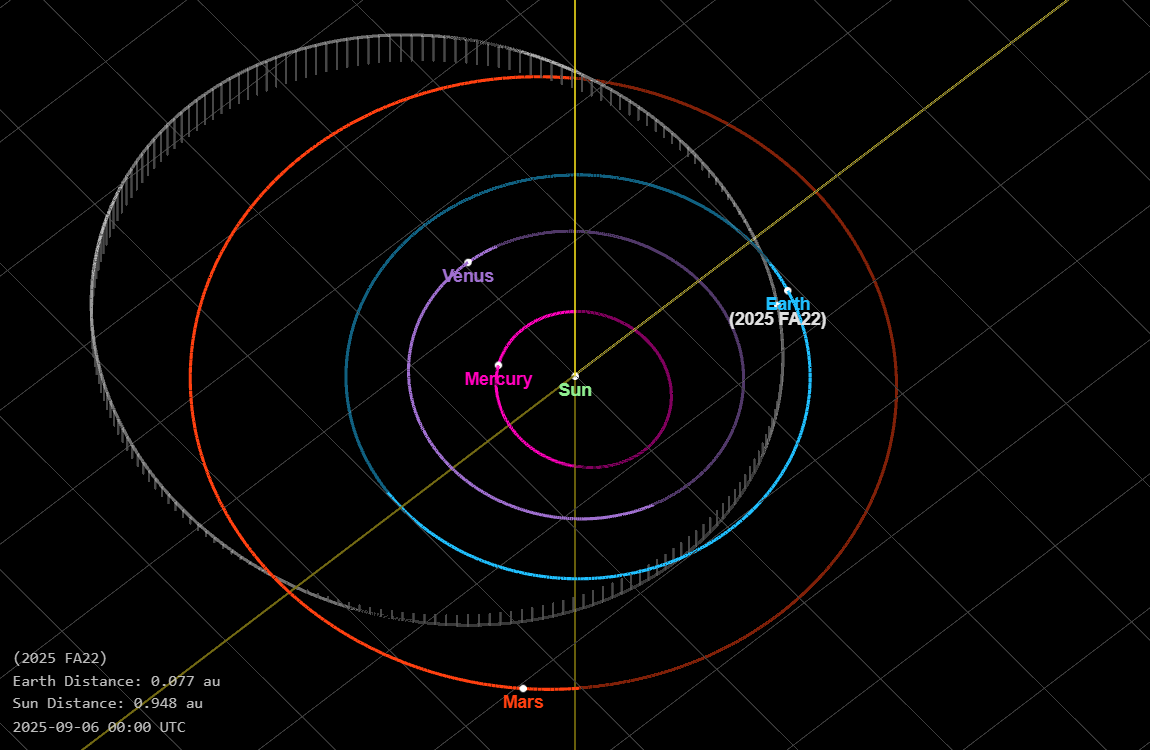The world is set for a once-in-a-decade event as the large and potentially hazardous asteroid 2025 FA22 makes a close approach to Earth. As it does so, the object should be visible to amateur astronomers equipped with small telescopes.
2025 FA22 was discovered on March 29 this year by the Panoramic Survey Telescope and Rapid Response System (Pan-STARRS 2) observatory in Hawaii. The asteroid is currently thought to be around 120–280 meters (394–919 feet) in size, making it a fairly sizeable object.
Near-Earth Objects (NEOs), particularly NEOs above 140 meters (460 feet) in size, are tracked by NASA and other astronomers and assessed for risk of impact with Earth. As part of this, they are given a “Torino” score of 0-10, with a score of 0 meaning the likelihood of impact is zero or thereabouts, and 10 meaning “a collision is certain, capable of causing global climatic catastrophe that may threaten the future of civilization as we know it, whether impacting land or ocean.” These are helpfully color-coded in green, yellow, and red, to clarify the situation to the public.
While the object has not been found to be on an impact course with Earth, it was briefly designated at Torino scale 1, indicating a large object which is unlikely to impact the planet, but should be observed further to make sure.
“Shortly after discovery, 2025 FA22 briefly reached Torino Scale 1 with a 10-5 chance of Earth impact in 2089,” NASA explains. “Additional observations reduced the chance of impact to zero.”
While impact is unlikely, 2025 FA22 is still predicted to make a number of close approaches. On its closest approach on September 21, 2173, the asteroid will be around 0.00288 AU from Earth, with 1 AU being the distance from the Earth to the Sun. That’s still a fairly comfortable distance of around 418,900 kilometers (260,200 miles), though it will bring it within the Moon’s orbit.
On September 18, 2025 at 07:42 am UTC, the object will approach at around 0.00563 AU.

Asteroid 2025 FA22’s close approach to Earth.
Image credit: NASA’s Small-Body Database Lookup
That’s around 841,900 kilometers (523,100 miles), further out than the Moon. On September 18 and 19, the asteroid will reach magnitude 13, potentially making it visible to observers with a small telescope.
It won’t only be amateur astronomers observing the object, of course. Though the object is not deemed hazardous, it will be watched closely by astronomers around the world.
“Precovery observations reported from Pan-STARRS 1 in 2014 and 2012 have reduced the orbital uncertainties substantially and pointing uncertainties with solution 24 are now small enough to support radar observations,” NASA explained.
“2025 FA22 will be the target of a coordinated, world-wide observing campaign for planetary defense under the auspices of the International Asteroid Warning Network [IAWN].”
The IAWN will attempt to collect data on the asteroid including its physical characteristics and orbit as it approaches the Earth.
“For the purpose of the exercise, we will treat this object as a current virtual impactor with a Torino Scale >= 1 with a hypothetical impact on September 19, 2089,” the IAWN explains.
“The campaign will start with the optical ‘recovery’ around September 17, 2025, when the object is between 40-60 deg. Solar elongation. The orbital improvement from recovery data is meant to facilitate rapid characterization of the target.”
While the network is set up to monitor threats, here it is only doing so as an exercise, and to take advantage of the opportunity presented by it. Asteroids this large approaching this closely happen only around once every decade. For those who would like to see it for themselves, a live stream will be put on by the Virtual Telescope Project on September 18.
Source Link: Once-In-A-Decade Close Encounter With Hazardous Asteroid 2025 FA22 Approaches